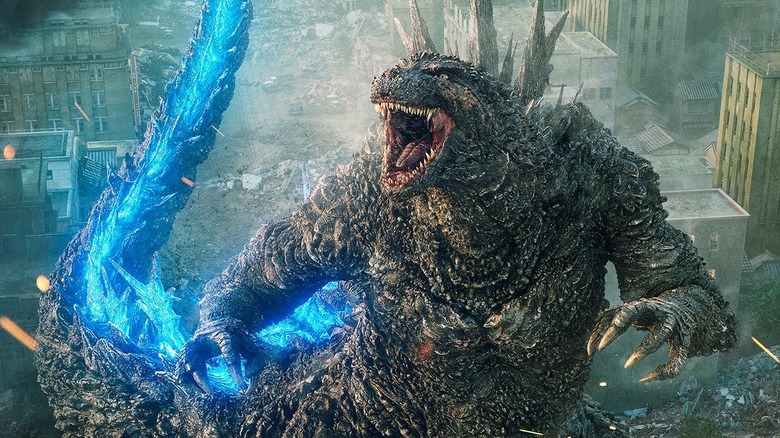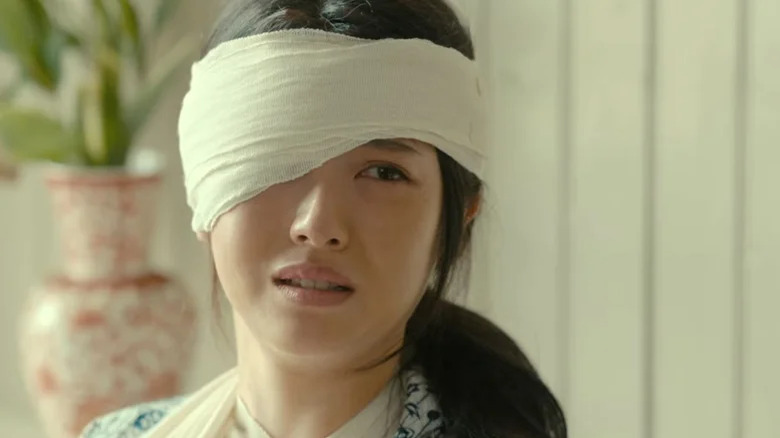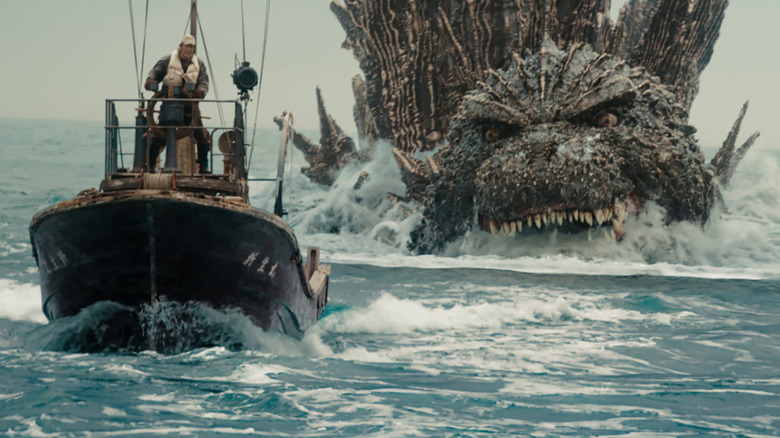Godzilla Minus One's Strangest Reveal Raises All Kinds Of Unanswered Questions
"Godzilla Minus One" is part of a new golden age of Godzilla, a movie that defied all expectations and made history at both the box office and also the Oscars. It's easy to see why. This is a film with fantastic visual effects that rival any Hollywood blockbuster, stunning Godzilla action, and a version of the king of the monsters that makes him terrifying again — a force of nature, a monstrous allegory for nuclear armageddon.
The film also does something rare for a "Godzilla movie" and actually gives us compelling human characters that are as easy to root for and care about as the titular giant monster. This is particularly important because for once, the most impactful moments in the film revolve not around Godzilla, but the humans. Take Godzilla's attack on Ginza, the first time we see his devastating atomic blast. What is normally a moment of awe turns into absolute horror as we witness it from the perspective of Noriko, who then sacrifices herself to save our protagonist Koichi by pushing him into an alley.
Except that's not the whole story. In the very final scene in the film, it's revealed that Noriko is very much alive, and in the hospital, the camera holds on her for a moment as a black mark, a vein-like growth, moves up her neck. This is arguably the strangest part of the entire film, and it immediately sparked discussion and theories about the mark actually being a piece of Godzilla that got stuck on Noriko, providing an explanation for why she survived the atomic blast. But does the theory hold up? What could it mean for a potential sequel? Let's explore.
The G-cells theory in Godzilla Minus One
After Godzilla uses his atomic breath, we see what look like scales falling off the creature, and after the attack on Ginza, there are mentions of "shards" left in his wake. The theory goes that a piece of one of those shards hit Noriko, and since we've seen that Godzilla has the ability to regenerate wounds, it stands to reason that the ability would extend to his scales and the contact with Noriko could have been the reason for her survival.
Aiding the theory are remarks "Godzilla Minus One" director Takashi Yamazaki made at Godzilla Fest in Osaka (via IGN), where he explained that the black mark on Noriko was the result of Godzilla cells, also called G-cells.
This is far from the first appearance of these G-cells. The concept was first introduced in the 1989 film "Godzilla vs. Biollante," where a scientist manages to splice some of Godzilla's cells with those of his deceased daughter and also a rose, accidentally creating the kaiju Biollante — which has the characteristics of Godzilla, but with a dash of plants for good measure. Though Godzilla defeats Biollante, her cells ended up falling into a black hole, where they get mixed with crystalline organisms and energy from exploding stars, ultimately creating SpaceGodzilla, co-star of the 1994 film "Godzilla vs. SpaceGodzilla."
Could the plot of a sequel to "Godzilla Minus One" be that Noriko somehow becomes a kaiju like Biollante? Stranger things have happened, of course, and the idea of humanoid kaiju was already part of 2016's "Shin Godzilla." That film ended with a shot of what look like human-sized Godzillas spawning out of the tail of the big guy himself, who was frozen to death.
A powerful reminder of real horror
Having human-sized kaiju in a Godzilla movie doesn't sound too strange, but is it likely for a sequel to "Godzilla Minus One?" After all, this film took a grounded approach to the franchise, bringing it back to the 1940s and making a big effort to make the monster an allegory for the war. Going off that idea, it's possible that Noriko surviving the blast is not meant to be a big reveal for the next movie, but just an allegory for the randomness of survivors of the atomic bombs dropped on Hiroshima and Nagasaki and the hope that humanity can endure even the worst of tragedies. It is possible that the shot of Noriko's black mark is nothing more than a coda, much like the mass of skeletal human kaiju rising from Godzilla's tail in "Shin Godzilla" that served as a cool final shot, a reminder that Godzilla's horror cannot be fully stopped.
But there is another possibility, one that still involves kaiju mutations, just not a kaiju like Biollante. One Redditor suggested that, to maintain the post-war allegory so prevalent in "Godzilla Minus One," maybe Noriko's black mark is the beginning of an exposure to radiation that will result in her and other survivors becoming like some of the real-life people who lived through the bombing of Hiroshima and were described as "ant-walking alligators," whose faces and eyes were burnt off and whose skin became like scales. This is a cruel, horrible, but extremely powerful idea that fits right in with the tone and message of "Godzilla Minus One" and could make a potential sequel strike an emotionally devastating chord.


